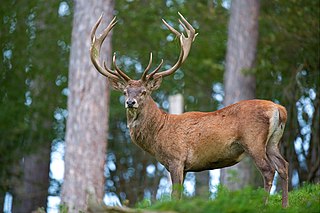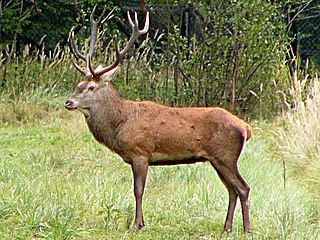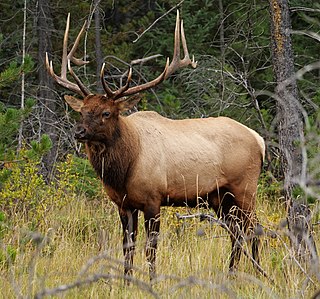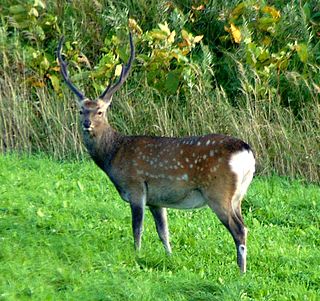
The sika deer, also known as the Northernspotted deer or the Japanese deer, is a species of deer native to much of East Asia and introduced to other parts of the world. Previously found from northern Vietnam in the south to the Russian Far East in the north, it is an uncommon species that has been extirpated in most areas of its native range, except in Japan, where it is overabundant and present in very large numbers.

Eld's deer, also known as the thamin or brow-antlered deer, is an endangered species of deer endemic to South and Southeast Asia.

The red deer is one of the largest deer species. A male red deer is called a stag or hart, and a female is called a doe or hind. The red deer inhabits most of Europe, the Caucasus Mountains region, Anatolia, Iran, and parts of western Asia. It also inhabits the Atlas Mountains of Northern Africa; being the only living species of deer to inhabit Africa. Red deer have been introduced to other areas, including Australia, New Zealand, the United States, Canada, Peru, Uruguay, Chile and Argentina. In many parts of the world, the meat (venison) from red deer is used as a food source.

Cervus is a genus of deer that primarily are native to Eurasia, although one species occurs in northern Africa and another in North America. In addition to the species presently placed in this genus, it has included a whole range of other species now commonly placed in other genera. Additionally, the species-level taxonomy is in a state of flux.

The elk, or wapiti, is the second largest species within the deer family, Cervidae, and one of the largest terrestrial mammals in its native range of North America and Central and East Asia. The word "elk" originally referred to the European variety of the moose, Alces alces, but was transferred to Cervus canadensis by North American colonists. The name "wapiti" derives from a Shawnee and Cree word meaning "white rump" for the distinctive light fur in the rear region, just like the Bighorn Sheep.

The island of Great Britain, along with the rest of the archipelago known as the British Isles, has a largely temperate climate. It contains a relatively small fraction of the world's wildlife. The biota was severely diminished in the last ice age, and shortly thereafter was separated from the continent by the English Channel's formation. Since then, humans have hunted the most dangerous forms to extinction, though domesticated forms such as the dog and the pig remain. The wild boar has subsequently been reintroduced as a meat animal.
Six species of deer are living wild in Great Britain: Scottish red deer, roe deer, fallow deer, sika deer, Reeves's muntjac, and Chinese water deer. Of those, Scottish red and roe deer are native and have lived in the isles throughout the Holocene. Fallow deer have been reintroduced twice, by the Romans and the Normans, after dying out in the last ice age. The other three are escaped or released alien species.

There are four species of deer living wild in Ireland today, namely red deer, fallow deer, sika deer, and the recently introduced Reeve's muntjac, which is becoming established. Recently, roe deer have been spotted in county Wicklow and county Armagh. The Irish elk and the red deer both became extinct in Ireland about 10,500 years ago during the Nahanagan Stadial. The reindeer was extirpated from Ireland about 9,500 years ago. Many of their skeletal remains have been found well preserved in peat land.

The North China sika deer or Mandarin sika deer is one of the many subspecies of sika deer. It is a large subspecies with some of the most prominent spots of all subspecies, which is permanent throughout the year. It previously inhabited lowland forests of North China Plain and Northeast China Plain. Because of intensive habitat alterations the subspecies was endangered centuries ago, surviving only in remote areas of northeastern China and the Qing Imperial Hunting Grounds. Though no surveys have been conducted on the subspecies' status, there have been no sightings for many decades and it is reasonable to presume that it is extinct in the wild. Although it is fairly common in zoos and purebred North China sika deer is a valuable breed in the Asian antler farming industry, the lack of suitable habitats and government efforts makes reintroduction impossible.
The South China sika deer is one of many subspecies of sika deer. Standing 85 cm or 33 in tall at the shoulders, it is a small subspecies that is only a little larger than its Japanese counterpart. The back is brown with a long dark vertebral strip flanked from indistinct white spots, the belly is snowy white. It has previously ranged from Yangtze River Basin all the way east to the coast, going as far south as the border with Vietnam. Today its small population of 300 is widely scattered along its former range, in remote mountains isolated by heavily populated lowlands. About 30 exists in the Tianmu Mountains in northern Zhejiang, 70 to 100 in southern Anhui, and 150 in northern Jiangxi. The population size in southern Guangxi is unknown, and a tiny population might exist in northern Guangdong as well. The population continues to decline due to poaching, and inbreeding is a matter of concern for the quality of its future population.

The Manitoban elk is a subspecies of elk found in the Midwestern United States and southern regions of the Canadian Prairies. In 2001–2002, a breeding population of 52 Manitoban elk was also introduced into the Cataloochee valley of the Great Smoky Mountains National Park in North Carolina to replace a population of Eastern elk which had gone extinct over 100 years prior. As of 2021, the population has grown to 150-200 individuals and has expanded their range outside of their initial protected region. In 2016, one of the elk from the North Carolina herd was spotted in South Carolina, the first time an elk had been seen in that state since the late 1700s.

The Formosan sika deer is a subspecies of sika deer endemic to the island of Taiwan. Formosan sika, like most of the terrestrial fauna and flora of Taiwan, arrived on the island during Pleistocene glacial periods when lower sea levels connected Taiwan to the Asian mainland.
The Sichuan sika deer is one of the many subspecies of sika deer. It was discovered in 1978 and was proven to be a distinct subspecies. It is found in the mountains of northern Sichuan and southern Gansu, which holds the largest population of Sika Deer in China. There are currently 500 individuals left in the wild, and the numbers currently seems to be stable.

The Vietnamese sika deer also known as the indochinese sika deer is one of the many subspecies of the sika deer. It is one of the smaller subspecies, due to the tropical environment they live in. They were previously found in northern Vietnam and possibly southwestern China, but may now be extinct in the wild. There are plans for reintroducing this subspecies in the future.

The Manchurian sika deer or Dybowski's sika deer is a subspecies of deer, the largest of the 14 subspecies of sika deer. It was first described by Robert Swinhoe in 1864.

The Yezo sika deer is a subspecies of sika deer that inhabits the northern Japanese island of Hokkaido. The Hokkaido sika are endemic, although it is not known whether they originated there or migrated from Honshū or areas further south. It is thought that they may have traveled across the Tsugaru Strait between the islands. Genetic study has shown that the separation of the sika population occurred less than half a million years ago. It is possible that northern sika deer may be more closely related to yezo sika deer than to other sika deer. The indigenous Ainu people of Hokkaido have hunted them for centuries and relied on them as a major food source.

The Kerama deer is an endangered subspecies of the Sika deer native to the Kerama Islands.













